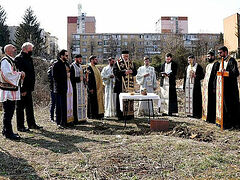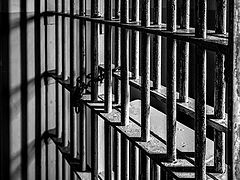Part 1. The The Life of Ioan Ianolide
At Pitești, a hell for students
“Between 1945 and 1964 this building housed a prison for anti-Communist political prisoners. Here, for the first time in history, the ‘Pitești experiment of re-education by torture’ was launched, which then spread to other prisons for political prisoners in Romania. Till the end of 1952, thousands of young people went through the experiment; about 100 of them died under torture, and the survivors had severe physical and mental traumas.”1
Although Ioan had already served seven difficult years in prison, in the summer of 1949 he was sent to Pitești Prison, since he was still listed as a student in the State security documents. However, under Antonescu (1940–1944) everyone who had been thrown into prison as students was in the same situation.
Upon arrival there he saw the phase that preceded the horrifying experiment of re-education, but nevertheless with hunger, cold and all sorts of humiliations. This was only the beginning, since the regime had already set the task of physically ruining and demoralizing all students so that they wouldn’t even have the strength to react to the endless torture inflicted on all “bandits” and “mystics”.
They felt that something was being prepared for them, but they couldn’t have imagined how monstrous the experiment would be. And one evening, right on Christmas Eve 1949, one of the inmates, returning after a “tour” of re-education, told Ioan what kind of horrors he had gone through and what methods of torture were used in cell 4 of the hospital, that it was impossible to endure it, and even death was not left to them as an alternative.
By the grace of God, Ioan was not subjected to re-education, but the next day he was brutally beaten by the cruel warder, Georgescu. The reason was the same: for Christ, since Ioan had earlier managed to hide a cross, an icon, and part of the Bible. He had worn the icon in his trousers, the cross in the right sleeve of his sweater, and he hid the booklet in his mattress. But Georgescu learned about the presence of the prohibited “objects”, so Ioan was ordered to give them away. Giving him the cross, he said to the warder:
“Mr. Georgescu, don’t fight against the Holy Cross—it’s beyond your strength!”
Hearing such a confession of faith, the butcher flew into a rage and began to trample on him with his boots and beat him with a crowbar, uttering wild cries like a demoniac until Ioan was bleeding all over.
After that he was given minimal medical care and again thrown into his cell, where he was informed about the new horrors that had occurred in his absence. He was told that several of his friends, who had strong faith and lucid minds, had been tortured by some “re-educated” students and to such an extent that they, too, had become “re-educated”. Horror-stricken, Ioan continued to pray:
“I didn’t see any way out, so I completely surrendered to the will of God. I felt that my mind was darkened, and I even more zealously implored Jesus to give me peace and light.”
An unbearable atmosphere of psychological terror reigned in the prison, but the spiritual experience acquired by Ioan became a shield for him in those terrible circumstances:
“Awaiting a ‘shift’, I prayed for ten, sixteen and even twenty hours a day, and at night prayer itself went on through my dreams. I had no falls in those circumstances because God shielded me, but I confess: I would rather have died than become spiritually dead and would have sought death if I had realized my inability to resist anymore. But God delivered me from that too, and so I have reached old age.”
The situation of extreme spiritual tension didn’t last, because one day, after so many years of torment by cold, hunger, and beatings, Ioan’s body could not withstand it, and blood suddenly gushed out of his throat:
“As I was weeping softly, I suddenly felt a hot wave rising from my chest to my head. I knew that now I would choke and die. I had a joyful feeling of an anticipation of freedom and was almost happy. Blood was streaming from my nose and mouth. I was lying in a puddle of blood. But I was feeling such relief in my body and soul! I forgave everything that had been done to me, and I felt pity for everyone. I expected that now I would die, and I was calm.”
The result was that Ioan avoided re-education by torture, because, having contracted tuberculosis, he was transferred to Târgu Ocna Prison’s hospital in early January 1950.
Târgu Ocna and Valeriu’s death
Although medical care at Târgu Ocna was minimal, the conditions were more adequate than at Pitești. Food was more or less sufficient, and they allowed inmates to walk in the open air and communicate with their relatives. So even though Ioan “was initially very sick, he recovered swiftly and devoted himself to caring for Valeriu Gafencu and other patients.” Suffering from tuberculosis, out of love for his brothers he didn’t spare himself, washing their dirty clothes and bedding, cleansing their wounds, cleaning up after them, serving them selflessly with all his might. Moreover, together with the confessors of the faith who were stronger, he performed vigils in the cell of dying inmates, and a profoundly Christian atmosphere of prayer reigned there.
 Church of St. Barbara in the former salt mines, where inmates of Targu Ocna Prison extracted salt
Church of St. Barbara in the former salt mines, where inmates of Targu Ocna Prison extracted salt
To his inexpressible disappointment, the tranquility of that atmosphere was disturbed by the arrival of the students who had gone through re-education in Pitești and had been ordered to begin re-educating those serving here. Ioan again had to go into the re-education cell, “where Pătrășcanu was waiting for him with several others transferred from Pitești.”2
Finally the re-education at Targu Ocna ended, and the prisoners even managed to restore to normality several “re-educated” students who had been physically and mentally disfigured by torture. One of them, moved by the love that Ioan showed him despite everything, once took his hand and kissed it. “That wonderful kiss has been burning me all my life,” Ioan later recalled.
But Ioan’s greatest concern was his true friend Valeriu. Every night he came to him in the cell of the dying inmates to cleanse his wounds, and they had endless theological conversations. Here Ioan watched at the head of the beds of dying inmates, and prayed as they passed into eternity. Then came February 18, 1952, when with unbearable mental pain he had to part with Valeriu, whom God had called to everlasting blessedness.
After Valeriu’s death, Pastor Richard Wurmbrand,3 astounded by the holiness of his life, asked Ioan to help him get baptized into Orthodoxy. Ioan postponed until the summer, explaining to him the serious consequences of that act. And then his Baptism was secretly performed by one of the imprisoned priests.
Ioan stayed at Targu Ocna till February 1953, after which he was transferred to Caransebeș, then to Jilava and again to Aiud.
And again Aiud
 Aiud, maximum security penitentiary
Aiud, maximum security penitentiary
In December 1954, Ioan was transferred to the tuberculosis ward. The attending physician there was Gheorghiu, a university professor and a prisoner. A man of a noble soul, he allowed sick inmates to take scraps of paper left over from medicine and write on them with pointed sticks. Thus did the tuberculosis department become an “institute” where they could study philosophy, psychology, pedagogy, mathematics, chemistry, foreign languages and much more. Ioan attended these “courses” too.
To be continued...





